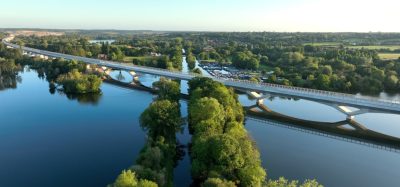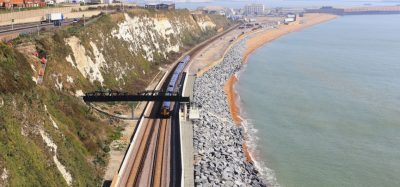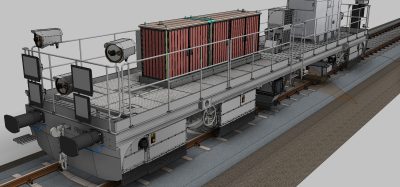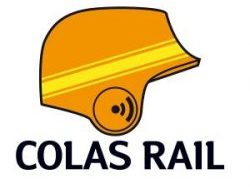Investment in track monitoring increases
Posted: 15 September 2006 | | No comments yet
Keeping on top of the condition of your track can pay dividends in terms of improved ride and reduced maintenance bills. Modern monitoring equipment allows engineers to plan predictive maintenance. Europe’s railways are stepping up spending on track testing and monitoring. Traditionally, track maintenance has been reactive: in this case, track is tamped and restored to good condition after quality has started to slip. The aim is to move to a proactive position, where engineers are intimately aware of track condition through continual testing and are able to maintain quality before it starts to slip.
Keeping on top of the condition of your track can pay dividends in terms of improved ride and reduced maintenance bills. Modern monitoring equipment allows engineers to plan predictive maintenance. Europe’s railways are stepping up spending on track testing and monitoring. Traditionally, track maintenance has been reactive: in this case, track is tamped and restored to good condition after quality has started to slip. The aim is to move to a proactive position, where engineers are intimately aware of track condition through continual testing and are able to maintain quality before it starts to slip.
Keeping on top of the condition of your track can pay dividends in terms of improved ride and reduced maintenance bills. Modern monitoring equipment allows engineers to plan predictive maintenance.
Europe’s railways are stepping up spending on track testing and monitoring. Traditionally, track maintenance has been reactive: in this case, track is tamped and restored to good condition after quality has started to slip. The aim is to move to a proactive position, where engineers are intimately aware of track condition through continual testing and are able to maintain quality before it starts to slip.
The approach was pioneered in Japan, where the famous ‘Dr Yellow’ inspection trains travel the Shinkansen high-speed lines every night assessing infrastructure condition. The Japanese are proud that in four decades of operation no passenger has lost a life on the Shinkansen network – and perpetual good track quality has had a role to play in this enviable record.
In Europe, the UK is generally thought to be at the top of the league in track monitoring. The accident at Hatfield on the East Coast main line out of London King’s Cross in October 2000 prompted huge investment in track monitoring machinery: four people lost their lives when rail disintegrated under a high-speed train. Emergency speed restrictions were applied across the network while the cause was investigated. The consequent chaos was a major factor in the financial meltdown of the privatised infrastructure company Railtrack and its replacement by the not-for-profit company Network Rail.
Rolling contact fatigue and gauge corner cracking, in which a small crack in the railhead had been allowed to propagate into the rail web precipitating a rail break, were found to be the cause of the accident. Clearly, Network Rail needed to know where cracks were forming and nip the problem in the bud if another Hatfield was to be avoided.
As a result, there has been heavy investment in the UK in equipment to assess rail condition. Three trains equipped with ultrasonic testing equipment from Sperry of the US ply the rails around the country. There is also a road-railer fitted out with this equipment: this is for use on lines with long stretches of single track, such as those in rural Scotland. Using the vehicle’s rubber tyres, the roads can be used to access the track to be tested, thus minimising disturbance to revenue-earning traffic. These rail-borne vehicles are complemented by a stock of Sperry ‘walking sticks’, hand-held testing devices carried by on-track teams, which are especially useful for switch and crossing work.
With better knowledge of rail condition, Network Rail has initiated a comprehensive rail grinding programme. Before Hatfield, little grinding was undertaken, and the chief purpose of it was to remove corrugation in the rail head to give a smoother ride. After Hatfield, substantial sums were spent on rail grinders with a view to eliminating gauge corner cracking by grinding off the top of the rail and eradicating cracks before they had a chance to propagate down into the rail web. Three 64-stone C21 machines were purchased from Loram of the US for grinding the main lines, and Harsco, also of the US, was contracted to supply five rail grinders for use on switches and crossings.
The Hatfield accident happened on a curve. With Network Rail’s grinding regime, cracks are removed on curves by grinding the high rail, in order to get the contact patch on the head of the rail and thus relieve the gauge corner. On low rails in curves and on straight sections, the C21s grind to maintain the profile of new rails.
The rule of thumb is to grind the rails on curves once for every 15 million tonnes of traffic; and on straight track, once for every 30 million tonnes of traffic. So taking Britain’s busiest route as an example, the West Coast main line out of London Euston serving the Midlands, the North of England and Scotland, on the fast lines the tracks carry about 40 million tonnes pa, so the grinders will be round a couple of times a year. The Loram C21s can grind at 15-20km/h on straight track and 10-13km/h in curves, so are able to operate as a slow train in a booked path. On a four-track route there is no need to book an engineering possession for grinders: service trains can simply be diverted round the grinders. On double-track routes, to avoid holding up service trains, grinding is usually done at night when trains are few and far between.
The intensive grinding regime in Britain has been shown to have positive economic impacts. Asset life of the track formation is lengthened, as corrugation on the rail or undue stresses tend to shorten the life of the sleepers and ballast.
New Measurement Train
While ultrasonic testing is useful for assessing rail condition, other information is needed on track geometry, overhead wire condition and so on if the infrastructure is to be kept in tip-top condition. For this reason, Network Rail invested in a train equivalent to the Japanese Dr Yellow trains. The British New Measurement Train (NMT) is formed out of a redundant diesel High Speed Train, which means it can travel on main lines at speeds up to 200km/h.
The NMT is equipped with state-of-the-art infrastructure inspection and measurement equipment, with French defence equipment manufacturer Cybernetix having supplied some of the high-tech equipment on board. Its 125mph top speed means it can cover a lot of ground, and it visits each of Britain’s key main lines every week. Huge amounts of data are generated by this train, and the NMT is complemented by a powerful data processing facility in Derby which can turn the raw data into something usable by the maintenance teams.
While the NMT for the British high-speed lines is formed from refurbished 30-year old vehicles, a brand new measurement train for the commuter lines south of London has been built by Plasser & Theurer in Austria. Many of these lines have a restricted loading gauge that could not accommodate the NMT, and this has been taken into account in the construction of the Plasser machine. This will be operated by the infrastructure company Carillion, in conjunction with Eurailscout of The Netherlands.
Measurement with service trains
Using passenger trains in normal customer service to assess the condition of the infrastructure is another advancing area. There may be space limitations on how much equipment can be accommodated, but the great advantage of a service train is the frequency of its trips, meaning asset condition can be closely monitored. Unmanned geometry measurement systems (UGMS) supplied by ImageMap of the US have been fitted to service trains on the Chiltern line running out of London Marylebone. These have been very useful in monitoring earthwork movement during periods of drought, when the soil dries out and has a tendency to move under the track.
320km/h measurement in France
Many of the developments seen in Britain are being replicated elsewhere in Europe. For example, ImageMap UGMS equipment has been fitted to TGV high-speed trains in France. And earlier this year, SNCF (French National Railways) launched its new €30 million dedicated infrastructure monitoring train, ‘IRIS 320’. The train is so named as it will monitor the track at speeds up to 320km/h.
The train, designed by SNCF’s Engineering Department, automatically monitors the condition of the track and records operational information from other systems, including signalling. The prime turnkey contractor for the delivery of IRIS 320’s track geometry recording system was AEA Technology Rail, the owner of the former British Rail Research laboratories. (AEA Technology plc has recently conditionally agreed the sale of its rail business, together with other non-core activities, to Vision Capital Ltd, an independent investment firm.)
The track geometry measurement contract included the provision of measurement acquisition equipment, installation and design engineering, safety and project management and data management and integration services. The system comprises ImageMap’s Laserail 4000, and AEAT’s Tracksys software. Tracksys records all measurement data relating to track geometry, which is stored in an integrated database for later assessment. The system also has the capacity to assess data in real-time and alert both the system operator and maintenance engineers to any urgent maintenance requirements during the course of a run. Therefore potentially dangerous inconsistencies can be addressed in a safe and timely manner, and with minimum disruption to railway operations.
Polish geometry car
A geometry car track measurement system has been supplied for use on PKP (Polish Railways) by the Graw company of Gliwice. The system consists of two main modules – the car real-time measurement module and the stationary data storage module. The measurement module is designed to work in the on-line (real-time) mode when driving along the track and in the off-line mode during calibration, simulation, and replay of stored results obtained in previous measurements. The user-friendly menu-controlled measurement module software has been developed on a QNX platform. The computer system of the geometry car can measure the track in both directions with speeds of up to 120km/h.
The measured parameters include: vertical irregularities, twist, track gauge, cant and horizontal irregularities of the track. The car measurement system interfaces its computer system with the vehicle’s sensors and calculates the distance travelled using odometer impulses. It calculates the primary geometrical parameters using on the car sensors’ readings and analyses defects, generating statistical data.
Keeping track of data
Keeping on top of the data generated by track measurement systems is essential if the information is to be translated into suitable work plans. Several proprietary systems undertake this task, one example being the Maintenance of Way Information System (MOWIS) produced by Zeta Tech Associates of the USA. MOWIS is designed to be used by maintenance supervisors responsible for daily and short-term maintenance, as well as by system managers responsible for planning annual and longer term maintenance.
The Toronto Transit System is one operator using MOWIS. In that city, the system map module of MOWIS provides a graphical display of the entire transit system with the option to display track component failures and/or rail defects. The system map also provides access to the track chart data in the database. The user can display additional levels of data by clicking on the desired station or segment.
The track chart module can display a ‘real-time’ track chart of any segment of the transit system. The track chart displays a range of data describing the rail, track fixation, curves, grade and so on. MOWIS is designed to provide accurate and easily definable data on current track defects and/or ‘exceptions’. These defects are presented graphically, colour coded for up to six defect levels, from ‘severe’ (red) defects to ‘housekeeping’ items (blue). These defects are entered based on track patrol (inspector) input, which can be done either through paper reports or hand held data entry units (with direct download capability).
Based on the maintenance and repair history of each track component, MOWIS provides a forecast of future component failures to be used for planning track maintenance, for budgeting capital and maintenance requirements and for purchasing and inventory maintenance. MOWIS also provides a forecast of rail life based on rail defects, traffic density, the type of rail and other parameters. The rail life forecast can similarly be used for budgeting rail replacement and associated capital planning.
Lasers
In Finland, laser beams are being used to increase the effectiveness of tamping. The system, developed jointly by the rail infrastructure company VR Track and local engineering firm Noptel Oy, measures the position of the railway track in two dimensions with a high degree of accuracy. This helps the vehicle’s track reinforcement mechanism to adjust the rail rapidly and precisely to the reference position.
In this application the lasers are used at low speed, but the same device uses a very high measurement speed (over 500 measurements/second) to produce profile data for the curves when it is used with measurement coaches.
British company Laser Rail also uses lasers to measure the track. A case in point is Cheadle Hulme station in Greater Manchester on the West Coast main line. The station here is located on a tight curve on a narrow embankment. Platform clearances for the recently introduced Pendolino tilting trains are tight, and the track ballast is glued. Therefore it was necessary to monitor the track for possible movement in relation to temperature during the early stages of fleet operation. The reason for this was to ensure that the control processes for guaranteeing clearances were working. Laser Rail was contracted by Network Rail to provide a dedicated monitoring system, which would enable regular measurements to be made without requiring track access on each occasion.
The Laser Rail project team developed a system of measuring transducers along with a computerised data logger, which records the track position at 12 locations, as well as the rail temperature on both tracks. These are sampled regularly, and recorded. The entire system was designed, approved, built, tested, installed and commissioned in less than four weeks. Using battery power, and consisting of minimal track-mounted equipment wired to a trackside cabinet, the equipment has been designed to form a rugged system, to operate in the hostile environment afforded by the railway.
‘Track stability is the key element in maximising the best use of loading gauge’ says Laser Rail. ‘With a thorough understanding of track stability, realistic tolerances can be used, rather than the conservative assumptions that are generally used.’
Global Railway Review Autumn/ Winter Issue 2025
Welcome to 2025’s Autumn/ Winter issue of Global Railway Review!
The dynamism of our sector has never been more apparent, driven by technological leaps, evolving societal demands, and an urgent global imperative for sustainable solutions.
>>> Read the issue in full now! <<<







